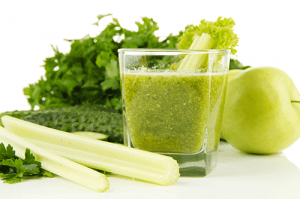I’m often asked the question about juicing and blending and if one is better than the other. I’m not a big fan of juicing, especially juicing with fruit because of the high sugar content and loss of all fiber. I much prefer blending of green smoothies using leafy green vegetables and a small amount of fruit. Dr. Joel Fuhrman weighs in on the topic very nicely providing great information. I couldn’t say it any better.
My smoothie this morning included bok choy, pomegranant seeds, frozen pineapple, a handful of ice, 1/4 cup of water and a handful of spinach. It’s a great morning meal and really filling. Dr. Fuhrman’s article is below.
Which is Better for my Health, a Green Juice or a Green Smoothie?*
Vegetable juices and green smoothies (also called blended salads) both have a place in the diet. Both are great ways to get more raw leafy greens into your diet, in addition to your usual salads.
Satiety and blood glucose
A green smoothie — a blended mix of leafy greens, fruits and nuts and/or seeds — is an excellent, portable morning meal. It contains all the fiber from the greens and fruit, plus fat from the nuts or seeds to keep you full and limit the rise in glucose from the fruit.
A vegetable juice with a small amount of fruit, depending on size, may be as calorie-dense as the smoothie, but will not be a satisfying meal on its own. For this reason, if you have a substantial amount of weight to lose, I wouldn’t recommend juicing often because it will likely add too many extra calories (without the feeling of satiety) and compromise your weight loss efforts. Also for those with diabetes, I do not recommend juicing, since the sugar in the juice enters the bloodstream rapidly without fiber from the original vegetables and fruits to slow the process.
Micronutrient availability
Blending and juicing both disrupt the mechanical structure of plant cells, which increases the accessibility of many micronutrients. Many beneficial micronutrients – carotenoids, polyphenols, and folate for example — are often bound to structural components or large molecules within the plant cell like fiber, proteins, and starches. Processing, heating, and chewing break down these cellular structures to increase the availability of the bound micronutrients; however, many may not be accessible for our absorption by chewing alone. Blending increases our likelihood of absorbing these nutrients. Importantly, the micronutrients that are bound to fiber within the plant cell may be removed with the fiber by juicing and therefore be more available via blending than juicing.
Also, with smoothies, you are often adding nuts or seeds as a healthful fat source. Although blending alone increases the accessibility of carotenoids, since the presence of fats is known to increase carotenoid absorption from leafy greens, it is possible that nuts and seeds in a smoothie could increase absorption further.
For those who have nutrient absorption problems, gastrointestinal conditions, or other medical conditions, vegetable juices (especially cruciferous vegetables) are often useful as a supplement to a healthful diet, providing additional beneficial nutrients to promote healing.
Guidelines for juicing and blending:
- By blending, you get everything that you would get in juice, so juicing is not a necessary component of a healthful diet.
- Whereas a green smoothie can be a meal, think of a vegetable juice as a supplement to add extra leafy green-derived nutrients to a healthful diet.
- If you do juice regularly, make sure that you are not replacing your leafy green salads and whole raw vegetables with juices.
- Whether you are juicing or making smoothies, be sure to put a greater focus on vegetables than fruit; use only a small amount of fruit to add flavor, so that you maximize nutritional value and limit glycemic effects.
- Limit smoothies and green juices to one per day, and remember that this does not remove the necessity to utilize your teeth to eat a raw salad every day.
*Accessed from Joel Fuhrman MD: Author, Eat to Live



